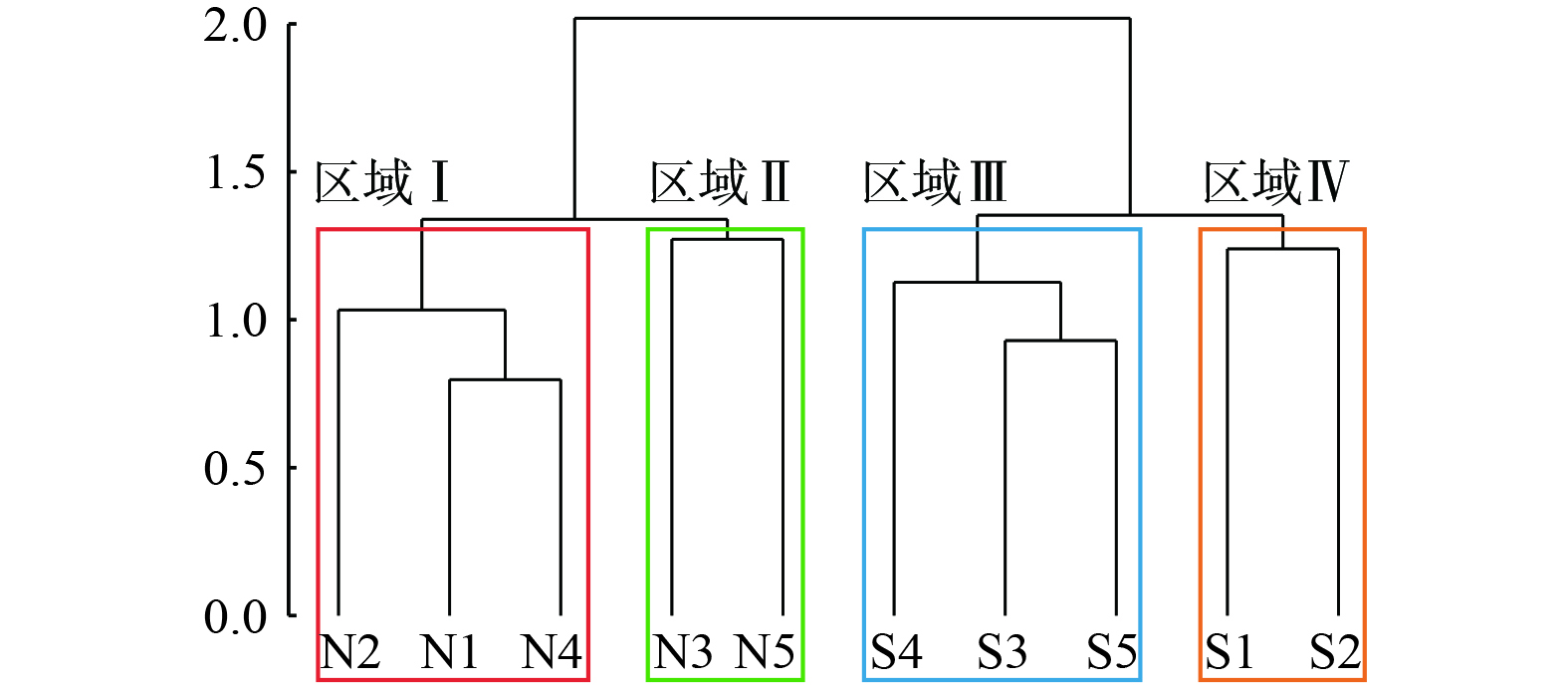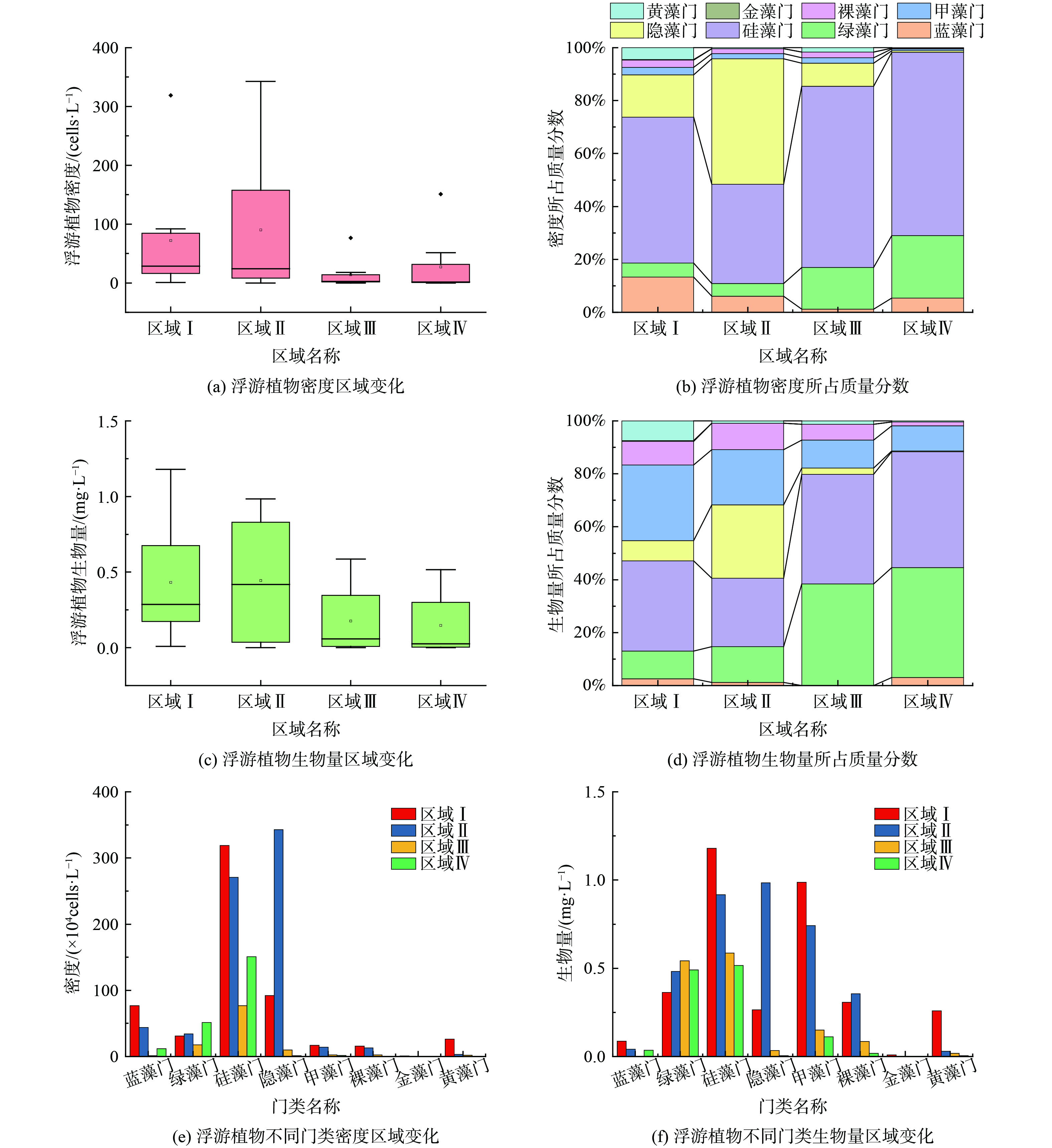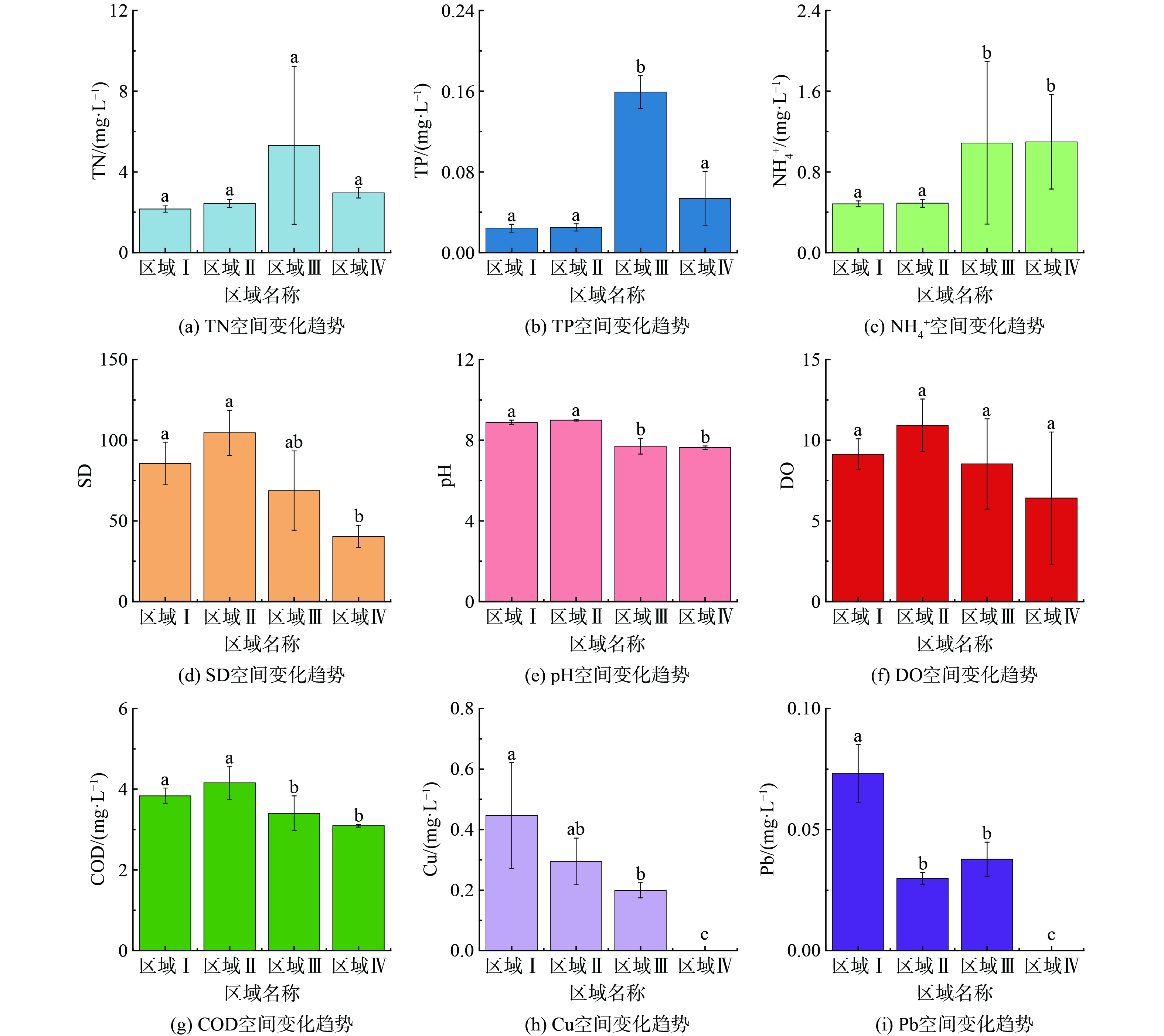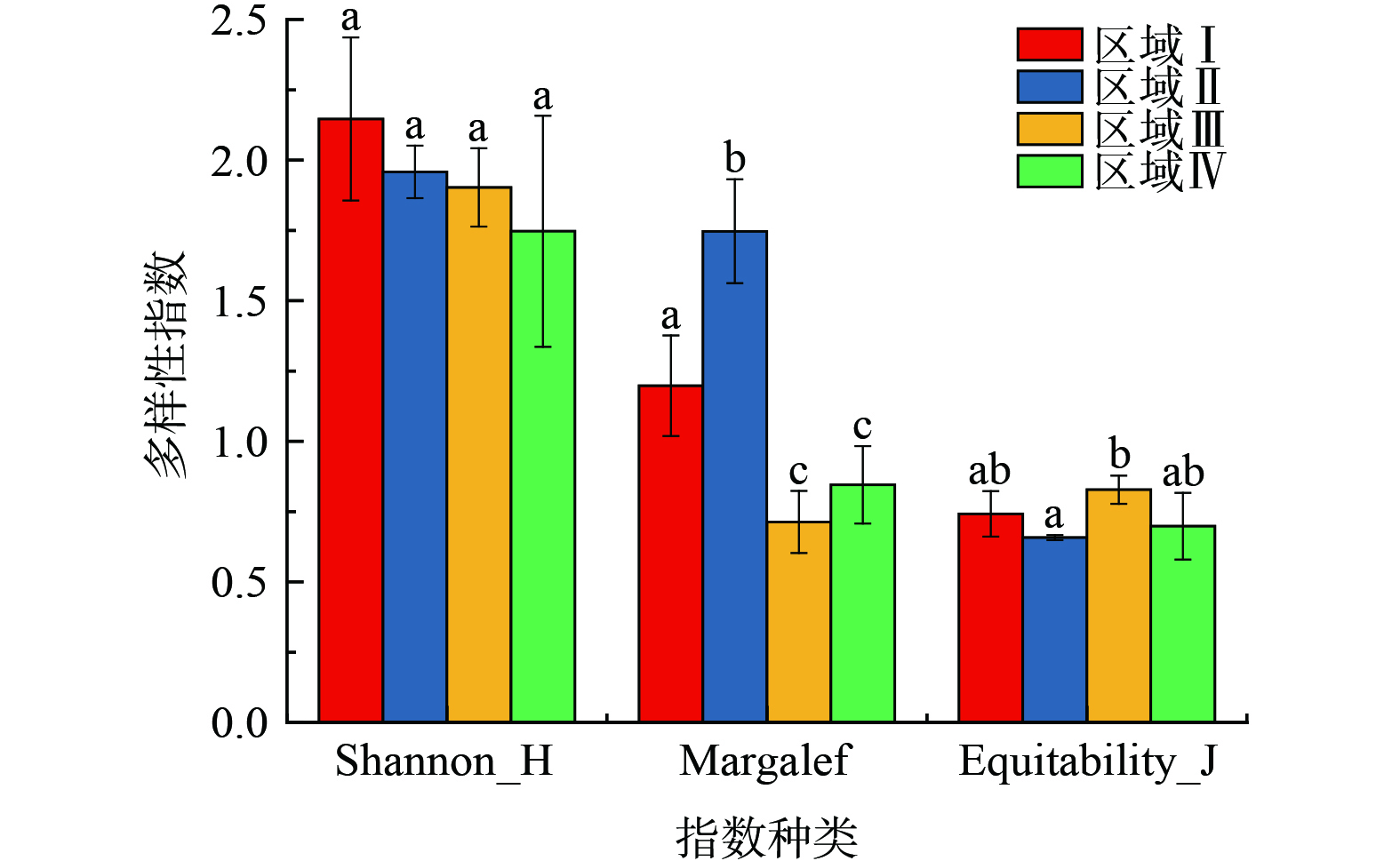-
城市人工湖是一种介于河流和湖泊之间的半自然半人工的水体[1-2]。城市人工湖水体环境受到自然条件、用地范围、水面功能需求等因素的影响[3]。由于人工湖水深较浅、面积相对较小,与自然湖泊相比水体自净能力较差,容易暴发水体富营养化、出现水体恶臭等现象[4]。不同人工湖不同区域污染状态及富营养化成因存在差异,其水环境控制策略也不同。徐后涛等[5]基于对城市人工湖的研究,提出利用水生生物食物链及生物操纵理论改善水质并恢复水生态系统的平衡方法。魏秘等[6]通过控制总氮等营养盐的输入以改善梅溪湖水质综合营养状态。还有研究者通过实施控源截污、内源清淤、生态修复、应急保障恢复和长效运维等工程措施[7],并结合炭素纤维生态草、微纳米气泡发生装置、纯氧发生器、人工干预与生物处理相结合的生态浮床,以及植物栅和水下森林等环保新材料和装备[8-9],以期改善人工湖水质和水生态。对于不同人工湖富营养化的治理,应针对水体富营养化分布特征及成因提出有针对性的科学合理策略。
湖泊富营养化的形成与浮游植物及环境因子密切相关。浮游植物是水生系统中重要的初级生产者,也是水生生物群落结构中重要的组成部分,在维持湖泊、河流及湿地等生态系统稳定性和完整性方面起着重要作用[10-11]。由于浮游植物对于环境变化的敏感性,常被用于环境监测和水体富营养化评价的指示生物[12-13]。在天然水体中,受水环境的营养型影响,浮游植物的种类、密度及生物量都存在着一定空间异质性,且影响浮游植物分布格局的主要环境因素各不相同。ZHU等[14]使用预测模型发现洱海浮游植物演替的关键环境因子包括总氮 (total nitrogen,TN) 、总磷 (total phosphorus,TP) 、溶解氧 (dissolved oxygen,DO) 、透明度 (secchi disc,SD) 、电导率 (conductivity,Cond) 、温度 (water temperature,WT) 和氧化还原电位 (oxidation-reductionpotential,ORP) 。XIAO等[15]研究长江中下游81个湖泊,发现不同尺度的空间因子相较于环境变量对浮游植物群落格局的影响更大。此外,水动力特征如水位波动及水流速、流量的不同,也会影响浮游植物群落结构分布的差异[16-17]。目前,许多研究揭示了天然湖泊空间异质性和环境因子对浮游植物群落结构及分布的影响[18-19]。因此,有必要开展城市人工湖空间异质性和环境因子与浮游植物群落关系的研究。
本研究基于福州某城市人工湖水环境因子和浮游植物群落数据,运用聚类分析 (CA) 、主坐标分析 (PCoA) 及冗余分析 (RDA) 方法,进一步探究该城市人工湖不同区域中浮游植物群落结构的差异及造成差异的驱动因子,并根据不同空间的富营养化状态和污染特点提出精准控制措施,以期为城市人工湖的生态治理和保护提供参考。
-
本研究以福建省福州市某城市人工湖为研究对象。该湖北起化工路,接牛岗山海绵公园,南至福新东路,西至连江北路。湖体位于凤坂河片区,上游为凤坂河和凤坂一支河,其中凤坂河连接着晋安河及化工河上游的登云水库。湖体库容达151×104 km2,集水面积为20.5 km2,具有重要的调蓄功能和生态景观功能。
本研究于2023年2月和4月 (春季) 对该城市人工湖开展浮游植物和水质样品的采集。根据湖区和外围河道面积形态特征,共设置10个采样点 (图1) 。其中,N1~N5位点位于该城市人工湖湖区;S1及S2位点分别位于人工湖上游河流——晋安河和凤坂河;S3及S4位点分别位于化工河、凤坂二支河与凤坂河的交界处;S5为凤坂一支河与人工湖交界处。其中,S3位点处于该人工湖1号闸,为凤坂河入湖口; S5位点位于5号闸门,为凤坂一支河入湖口,2个闸门均为生态补水、分洪闸;N2位点位于2号出水闸,连接凤坂河;N4位于4号出水闸,连接凤坂一支河,2个闸门起着生态补水、分洪、挡潮的作用。
-
利用采水器采集水样,用于水质指标检测和浮游植物种类鉴定。采集原则为:当水深≤2 m时,分别取0.5 m和1.5 m水深处水样,将两者混合均匀;当水深>2 m时,按1 m为间隔分层采样并进行混合。
取混合水样1 L加入4% (质量分数) 福尔马林和鲁哥氏碘液进行固定,静置48 h后,吸去上清液,浓缩至50 mL,将浓缩后样品摇匀,取0.1 mL于帕默尔计数框内进行游植物种类鉴定和计数,具体方法参考文献[20]。
参照《地表水环境质量标准》 (GB3838-2002) 及《水和废水监测分析方法》[21-22]测定水样中总氮 (TN)、总磷 (TP)、氨氮 (NH4+) 、高锰酸盐指数 (COD) 及多种重金属质量浓度。测定的重金属种类包括铜 (Cu)、铅 (Pb)、锌 (Zn)、镉 (Cd)、硒 (Se) 和六价铬 (Cr6+) 。除Cu及Pb外,其余重金属质量浓度均在检出限以下。此外,现场使用便携式YSI多参数水质分析仪现场测定水温 (WT)、pH、溶解氧 (DO),使用塞氏盘测定水体透明度 (SD)。
-
浮游植物密度 (N) 、优势度 (Y) 、Shannon-Wiener多样性指数 (H’) 、Pielous均匀度指数 (J) 、Margalef丰富度指数 (D) 及水体综合营养指数 (TLI) 计算公式分别为式 (1)~(7) 。
式中:N为浮游植物密度,cells·L−1;CS为计数框面积,mm2;FS为每个视野的面积,mm2;Y为优势度指数;Fn为计数的视野数,个;V为1 L水样经过浓缩后的体积,mL;U为计数框的面积,mm2;Pn为计数出的浮游植物总数,个;Fi为第i个物种出现的频率;ni为第i种的个体数;n为同一样点种的个体总数;H'为Shannon-Wiener指数值;S为物种数;Pi为i种个体占个体总数的比例。Y>0.02为优势种;J为Pielous均匀度指数;D为Margalef丰富度指数;TLI为综合营养状态指数;Wj为第j种参数的营养状态指数的相关权重;TLI(j)为代表第j种参数的营养状态指数;rij2为第j种参数与基准参数Chla的相关系数;m为评价参数的个数。
其中,TLI指数计算时选取透明度 (SD) 、叶绿素a (Chla) 、高锰酸盐指数 (CODMn) 、总磷 (TP) 、总氮 (TN) 5个参数作为评价指标,具体计算方式参照《湖泊 (水库) 富营养化评价方法及分级技术规定》[23]。
-
Shannon-Wiener指数,Pielous均匀度指数,Margalef丰富度指数及TLI指数评价标准见表1。
-
将城市人工湖浮游植物密度和水环境因子进行lg(X+1)转化后进行聚类分析 (cluster analysis, CA) ,依据空间差异性结果对其进行区域划分。根据浮游植物群落结构之间的jaccard距离矩阵进行主坐标成分分析 (principal coordinates analysis, PCoA) ,以确定不同组别之间的群落β多样性。对浮游植物群落信息进行去趋势对应分析 (DCA) ,排序轴梯度长度小于3,采用冗余分析 (RDA) 研究浮游植物群落与环境因子的相关性。数据分析采用R软件包中的“vegan”、“ggplot2”软件包进行分析。采用SPSS 21.0统计包进行单因素方差分析 (one-way ANOVA) ,当方差分析结果P<0.05时,认为具有显著性差异。相关科学图表采用Origin 2022软件进行制作。
-
对城市人工湖10个采样点的浮游植物群落结构和环境因子进行聚类分析,依据结果将其分为4个空间区域 (图2) 。区域Ⅰ包括N1、N2和N3,区域Ⅱ为N4及N5,区域Ⅲ为S3、S4及S5,区域Ⅳ为S1、S2位于凤坂河上游。
本研究共鉴定出浮游植物8门42种,包括蓝藻门12种、绿藻门10种、硅藻门10种、隐藻门2种、甲藻门4种、裸藻门2种、黄藻门1种及金藻门1种。4个区域浮游植物优势种共有12种。其中,硅藻门种类最多为5种,绿藻门次之占2种 (表2) 。4个区域浮游植物硅藻门密度占整个物种质量分数的40%以上 (图3 (a)~(b) ) 。水温是影响浮游植物生长及群落演替的重要因子[25-26]。该城市人工湖及其外围河道春季水温为18~20 ℃,硅藻在低温情况下具有一定优势[27],而绿藻在春季回暖时会逐渐复苏和生长[28],故春季主要以硅藻和绿藻为优势物种。
此外,4个区域的浮游植物平均密度分别为24.09×104、45.14×104、4.67×104和13.62×104 cells·L−1,平均生物量为0.14、0.22、0.06和0.07 mg·L−1。区域Ⅰ和区域Ⅱ浮游植物密度和生物量显著高于区域Ⅲ和区域Ⅳ (图3 (a)~(d) ) 。人工湖湖区中心为浅层滞缓流水体,其水体流动更新缓慢、滞留时间较长为藻类的生长提供较适宜的环境[29]。因此,当水温逐渐升高且光照充足时,浮游植物在湖区中心大量繁殖且密度不断增加。值得注意的是,区域Ⅱ中隐藻门的密度和生物量均显著高于其他3个区域 (图3) ,这是由于带鞭毛的隐藻则适合在水流缓、水力滞留时间长且有机质浓度较高的水体中,即使在低光照条件下也能利用外界无机营养盐作为能量物质[30],故区域Ⅱ的水体环境促使隐藻占据优势。
-
城市人工湖环境因子分析结果显示,不同区域之间特征污染物类型存在空间上的差异 (图4) 。TN、TP和[NH4+]在区域Ⅲ更高,分别达到5.31 mg·L−1、0.16 mg·L−1和0.8 mg·L−1 (图4 (a)~(c) ) 。区域Ⅲ附近分布有较多住宅区及商业区,生活污水的过量排放导致营养盐输入情况更为严重。同时,河道水体流速较快,导致营养物质较易发生迁移及释放[31-33],从而引起水体营养盐增高。
在人工湖湖区内,区域Ⅱ的SD、DO和COD较高,分别达到1.05、10.92和4.15 mg·L−1 (图4 (d)~(f))。水体DO是衡量初级生产力状况及污染状态的重要指标。区域Ⅱ浮游植物密度较高,而浮游植物作为水体中DO的供应者,其大量繁殖导致DO升高[34]。其次,湖水透明度是评价湖泊富营养化的重要指标,能直观反映湖水混浊程度[35]。通常情况下,浮游植物生物量的增加将导致湖泊透明度的下降。然而,区域Ⅱ浮游植物主要的优势种为硅藻和隐藻。由于硅藻具有透明的细胞壁,而隐藻细胞较小不易聚集成块,并无明显的吸光和散射效应,故其生物量的增加对透明度的影响较小[36]。另外,区域Ⅱ位于湖区中心,泥沙的浓度较小,水体扰动程度较低,其SD受到悬浮物影响较小,故该区域SD较高。此外,湖泊COD是反映水体中有机物质量浓度的指标,浮游植物生长和死亡过程会产生并释放有机物,从而导致COD增大[37]。区域Ⅱ浮游植物生物量较高,其浮游植物生物量的增加伴随着水体COD增大。
而区域Ⅰ水体Cu和Pb质量浓度最高,分别达到0.45 mg·L−1和0.07 mg·L−1 (图4 (d)~(i) ) 。该区域位于该人工湖闸坝设施处,闸坝水体由于闸坝的控制,沉积物中重金属质量浓度往往高于自然水体,受扰动后重金属易发生迁移并释放至水体[38],由此揭示了区域Ⅰ重金属质量浓度较高的原因。
-
首先,采用综合营养指数法评价城市人工湖4个区域营养状况,指数均高于40,为中营养。区域Ⅲ和区域Ⅳ的综合营养指数高于区域Ⅰ和区域Ⅱ (表3) ,且综合营养指数最高值出现在区域Ⅳ,为46.83,主要表现为TP、TN和SD营养状态指数较高,其中SD营养状态指数达到68.90。区域Ⅳ位于河道沿岸区,河滨岸带的氮磷营养盐更易随着地表径流流入该区域的水环境[39],且其为该人工湖水源补给河道,其扰动程度和扰动频率相对较大,会导致底泥悬浮现象更严重[40]。这表明该区域水质普遍比湖区内浑浊,水体透明度偏低,造成SD营养指数偏高。
进一步采用浮游植物多样性指数评价水生态系统的健康程度[41-42],结果如图5所示。浮游植物Shannon-Wiener 多样性指数 (H’) 为1.75~2.15,区域Ⅰ的H’最高。Shannon-Wiener 多样性指数通常反映群落的物种多样性,该指数越高通常与较低的污染情况相关,这表明在相对较少的污染或较为良好的环境条件下,各种物种可较好地生存和繁殖,从而导致较高的物种多样性。Margalef 丰富度指数 (D) 为0.71~1.75,最大值出现在区域Ⅱ。Margalef丰富度指数则是指群落或生境中物种数目的大小,其与污染程度呈现负相关,即在较高水平的污染或环境破坏的情况下,生态系统可能会发生变化,导致物种数量的减少。此外,Pielou 均匀度指数 (J) 为0.66~0.83,最大值在区域Ⅲ。Pielou均匀度指数是物种群落实测多样性和最大多样性的比率,较低的Pielou指数意味着物种相对丰度的不均匀性较高,其与污染程度与 Pielou指数呈现负相关。根据浮游植物多样性指数显示,区域Ⅰ的H’较高,而区域Ⅱ的D丰富度指数显著高于其他地区,二者均为中污染型水体。区域Ⅲ、Ⅳ则为轻污染型水体。
以上结果表明,综合营养状态指数和多样性指数结果呈现的水体污染情况具有一定差异。综合营养状态指数主要关注的是营养元素的质量浓度,用于评估水体中营养盐状况;而多样性指数则主要关注物种组成和相对丰度的变化,用于描述生物群落或生态系统的物种多样性程度的指标。两者均提供有关环境或生态系统的重要信息,综合使用这2种指标可更全面地掌握生态系统的健康状况和物种多样性,并针对性的提出精准治理措施。
-
利用PCoA分析不同区域间浮游植物群落β-多样性的相似度,前两轴分别解释了45.34%和18.96%的群落组成变化。同时,通过ANOVA对Jaccard排序距离分析发现,浮游植物在区域Ⅰ、Ⅱ和区域Ⅲ、Ⅳ间存在显著的空间差异 (P<0.05) (图6 (a))。进一步通过RDA分析揭示了影响区域间浮游植物群落差异的环境因素 (图6 (b))。结果表明,区域Ⅰ和区域Ⅱ主要受到水体Cu、Pb和DO的影响。区域Ⅰ位于该城市人工湖各闸坝口并靠近湖滨岸带,春季时大部分时间处于关闸蓄水阶段,水体相对静止。由于闸坝的开闭情况对于水体污染物的积聚和迁移有重要影响[31],闸坝关闭开始蓄水后,河流水动力条件减弱,导致水库泥沙淤积,致使部分颗粒物携带的重金属沉降而引发二次污染。进一步地,在蓄水后,被淹没的土壤中有毒有害物质将通过溶解、交换、扩散而迁移到河流水体中,增加其相应成分的浓度[43],故区域Ⅰ的重金属积聚相较于其他3个区域更为严重。
与区域Ⅰ不同,区域Ⅱ浮游植物生物量显著高于其他区域,DO与浮游植物存在相互作用的关系。一方面溶解氧供给浮游植物进行呼吸作用,而另一方面浮游植物的光合作用及死亡后分解均会产生溶解氧[32],故区域Ⅱ与DO呈显著相关。
影响区域Ⅲ和区域Ⅳ的主要环境因素为TN、TP和[NH4+]。区域Ⅲ、Ⅳ相较于区域Ⅰ、Ⅱ,附近有较多居住用地、商业用地和交通用地,且区域Ⅳ作为该城市人工湖水源补给河道,其水体流速较快。以上结果表明,旱地农田、建筑用地占比对河道氮、磷等营养盐相关水质指标影响较大[44];其次,水动力扰动也是影响河道底泥释放营养盐及营养物质迁移的重要因素,比如总氮和总磷与流速呈指数关系,其质量浓度随流速增加而显著增加[38,45]。因此,土地利用程度及水动力扰动会导致区域Ⅲ、Ⅳ营养盐污染更为严重。
-
针对不同区域的富营养状态和污染状况,分区域提出相应的治理办法能保障人工湖区的水质状况及景观生态。对于位于闸坝控制设施的区域Ⅰ类型的水体,应该统筹规划闸坝布局,探索建设具有生态功能的生态型闸坝,及时调整闸坝运行方式,优化调度模式,从而有效控制此区域重金属污染。而对于区域Ⅱ湖区内部水体,可通过适当水位升降来调节湖泊水动力情况,并通过合理投放适当比例、不同食性的鱼类、螺类及虾类,以及增加食物网丰富度控制藻类生物量。值得注意的是,区域Ⅱ也需通过减少污水排放和优化污水处理等关键措施有效控制水体有机质质量浓度,从而控制隐藻的生长。对于区域Ⅲ、区域Ⅳ河道水体,应采取截污措施控制外源污染的排入,减轻入河负荷,亦可通过控制河道水量、水流态等水动力特性以达到河流生态的要求。对于入湖河道内的河水应经过物理净化、生态净化、生物净化等多种技术手段进行强化净化,对河道内污染底泥进行疏挖,从而减轻内源释放污染。
-
1) 福州某人工湖浮游植物群落分布具有空间异质性,区域Ⅰ、Ⅱ浮游植物群落密度显著高于区域Ⅲ、Ⅳ。区域Ⅰ和区域Ⅱ浮游植物主要受到水体Cu、Pb和DO的影响,而影响区域Ⅲ和区域Ⅳ的主要环境因素为TN、TP和[NH4+]。
2) 综合营养状态指数和多样性指数结果呈现水体污染情况有一定差异。综合营养指数表明区域Ⅰ、Ⅱ为中营养状态,多样性指数显示城市人工湖区域Ⅲ、Ⅳ为轻污染型而区域Ⅰ、Ⅱ为中污染型。结合2个评价结果综合判断人工湖为中营养状态。
3) 综合考虑不同区域的污染成因,建议区域Ⅰ应调整闸坝类型和运行方式来控制此区域重金属污染,区域Ⅱ对应的滞缓流水体需控制水位及增加食物网丰度,区域Ⅲ、Ⅳ对应的河道水体应从截污和控源两方面减轻水体营养盐含量。
福州市某人工湖空间异质性和环境因子对浮游植物群落结构的影响
Analysis of the impact of spatial heterogeneity and environmental factors to community structure of phytoplankton in an artificial lake in Fuzhou, China
-
摘要: 城市人工湖水体的浮游植物群落时空分布特征及其富营养化风险会严重影响其生态景观功能,本研究对福州某人工湖的浮游植物群落结构和环境因子进行聚类 (CA) ,将其分为4个区域,并进一步分析不同区域的富营养化状态和污染成因,以提出针对性控制策略。结果表明,区域Ⅰ、Ⅱ浮游植物生物量分别为0.14 mg·L−1和0.22 mg·L−1,优势门分别为硅藻门和隐藻门,且TLI指数 (分别为41.46及42.92) 及浮游植物多样性指数 (分别为2.15及1.96) 显示两区域均为中污染型水体。区域Ⅲ、区域Ⅳ为出入湖水体,藻类含量较低, TLI指数为46.08及46.83,为中营养状态,浮游植物多样性指数为1.90及1.75,显示为轻污染型水体。浮游植物群落结构与环境因子相关性分析结果表明影响区域Ⅰ、Ⅱ浮游植物群落的环境因子为水体Cu、Pb、DO含量,而影响区域Ⅲ、Ⅳ浮游植物群落的环境因子为TN、TP及NH4+。针对4个区域的富营养状态和污染特点,提出了相应控制和治理策略,为人工湖开展精准生态治理提供依据和支撑。Abstract: The spatial and temporal distribution characteristics of phytoplankton communities in urban artificial lakes and their eutrophication risks will seriously affect their ecological landscape functions. This study conducted cluster analysis (CA) on the phytoplankton community structure and environmental factors of an artificial lake in Fuzhou, dividing it into four regions, and further analyzing the eutrophication status and pollution causes in different regions to propose targeted control strategies. The results showed that the biomass of phytoplankton in region I was 0.14 mg·L−1, mainly composed of diatoms. The highest biomass of phytoplankton in Region II was 0.22 mg·L−1, with cryptophyta and diatoms dominating. And regions III and IV were river water bodies with low algae content. The TLI index of all four regions are 41.46, 42.92, 46.08 and 46.83, indicating a moderate nutrient state, while the phytoplankton diversity index showed that regions I (2.15) and II (1.96) were moderately polluted water bodies, while regions III (1.90) and IV (1.75) were lightly polluted water bodies. The correlation analysis between the structure of phytoplankton communities and environmental factors showed that the environmental factors of phytoplankton communities in the affected areas I and II were the content of Cu, Pb, and DO in the water body, while the environmental factors of phytoplankton communities in the affected areas III and IV were TN, TP, and NH4+. Based on the pollution characteristics of the four regions, corresponding control and governance strategies were proposed to provide technical support for the ecological management of artificial lakes.
-
Key words:
- urban artificial lakes /
- phytoplankton /
- spatial heterogeneity /
- regionalized governance
-

-
Shannon-Wiener评价 Pielous评价 Margalef评价 TLI评价 Shannon-Wiener 水质类型 Pielous 水质类型 Margalef 水质类型 TLI 水质类型 >3 清洁型 0.8~1.0 清洁型 0~1 重度污染型 <30 贫营养 2~3 轻污染型 0.5~0.8 轻污染型 1~2 中度污染型 30~50 中营养 1~2 中污染型 0.3~0.5 中污染型 2~3 轻度污染型 50~60 轻度富营养 0~1 重污染型 0~0.3 重污染型 >3 清洁型 60~70 中度富营养 >70 重度富营养 表 2 城市人工湖不同区域浮游植物优势属
Table 2. Dominant species of phytoplankton in different regions of urban artificial lakes
优势种 区域 门类 种类 拉丁名 区域Ⅰ 区域Ⅱ 区域Ⅲ 区域Ⅳ 蓝藻门 平裂藻 Merismopedia sp. 0.0259 — — — 隐藻门 隐藻 Cryptomonas sp. 0.158 0.471 — 0.088 黄藻门 黄丝藻 Tribonema sp. 0.045 — — — 硅藻门 直链藻 Melosira sp. 0.265 0.199 0.136 0.145 小环藻 Cyclotella sp. 0.158 0.093 0.438 0.155 针杆藻 Synedra sp. 0.035 — — 0.105 舟形藻 Navicula sp. 0.051 0.047 0.070 0.181 菱形藻 Nitzschia sp. 0.030 — — 0.043 绿藻门 四角藻 Tetraedron sp. — — — 0.039 栅藻 Scenedesmus sp. 0.022 0.024 表 3 城市人工湖营养状态评价结果
Table 3. Evaluation results of nutritional status of urban artificial lakes
区域编号 TLI(Chla) TLI(TP) TLI(TN) TLI(SD) TLI(COD) TLI 营养级别 区域Ⅰ 23.83 33.76 67.54 54.36 36.84 41.46 中营养 区域Ⅱ 29.00 34.37 69.56 50.40 38.92 42.97 中营养 区域Ⅲ 14.46 58.08 79.91 59.42 33.53 46.08 中营养 区域Ⅳ 25.76 45.83 72.91 68.90 31.14 46.83 中营养 -
[1] ZHANG X Q, QIAO W B, ZHANG M H, et al. Improvement and evaluation of hydrodynamic conditions in plain regional drainage systems by artificial lakes: a case study of Xinxiang Economic Development Zone, China[J]. Environmental Science and Pollution Research, 2023, 30(31): 77642-77656. doi: 10.1007/s11356-023-27786-5 [2] 汪尚朋, 郭艳敏, 万骥, 等. 城市富营养化湖泊综合治理——以武汉北太子湖为例 [J]. 2021, 水生态学杂志, 42(4): 91-96. [3] 万杰, 冯炳燕. 基于城市水安全的人工湖水体工程设计[J]. 中国给水排水, 2014, 30(12): 73-76. [4] 张锴, 刘源, 龙伦明. 成都地区人工湖富营养化现状与防治措施[J]. 环境保护科学, 2013, 39(3): 34-37. [5] 徐后涛, 赵风斌, 张玮, 等. 城市人工湖的生态治理[J]. 环境工程学报, 2015, 9(9): 4300-4308. [6] 魏秘, 王瑞, 王竹等. 城市人工湖泊浮游植物群落结构及环境因子分析[J/OL]. 水生态学杂志: 1-20[2023-12-25]. http://kns.cnki.net/kcms/detail/42.1785.x.20220714.1134.002.html. [7] 韩小波, 王维康, 李燕, 等. 高密度城区人工景观湖(深圳荔枝湖)综合治理 [J]. 2023, 39(2): 120-124. [8] 唐清华, 高强, 庞志研, 等. 广州市白云人工湖生态修复工程设计 [J]. 2014, 8(7): 3083-3088. [9] 徐玲娥, 盛晟, 陆俊宇. 典型浅水型人工湖生态修复技术实践——以某园区中心湖水系为例[J]. 给水排水, 2021, 47(S1): 241-245. [10] YANG Y G, CHEN H H, AL M A, et al. Urbanization reduces resource use efficiency of phytoplankton community by altering the environment and decreasing biodiversity[J]. Journal of Environmental Sciences, 2022, 112: 140-151. doi: 10.1016/j.jes.2021.05.001 [11] ABONYI A, HORVATH Z, PTACNIK R. Functional richness outperforms taxonomic richness in predicting ecosystem functioning in natural phytoplankton communities[J]. Freshwater Biology, 2018, 63(2): 178-186. doi: 10.1111/fwb.13051 [12] LEVESQUE D, PINEL-ALLOUL B, GIANI A, et al. Are fluorometric, taxonomic, and functional indicators of phytoplankton community structure linked to environmental typology of urban ponds and lakes?[J]. Inland Waters, 2020, 10(1): 71-88. doi: 10.1080/20442041.2019.1678970 [13] YANG J, WANG F, LV J P, et al. Interactive effects of temperature and nutrients on the phytoplankton community in an urban river in China[J]. Environmental Monitoring and Assessment, 2019, 191(11): 634-645. [14] ZHU R, WANG H, CHEN J, et al. Use the predictive models to explore the key factors affecting phytoplankton succession in Lake Erhai, China[J]. Environmental Science & Pollution Research, 2018, 25: 1283-1293. [15] XIAO Z, LI H, LI X C, et al. Geographic pattern of phytoplankton community and their drivers in lakes of middle and lower reaches of Yangtze River floodplain, China[J]. Environmental Science and Pollution Research, 2022, 29(55): 83993-84005. doi: 10.1007/s11356-022-21657-1 [16] 李亚军, 张海涛, 肖晶, 等. 筑坝河流水动力条件对浮游植物动态变化的影响[J]. 地球与环境, 2019, 47(6): 857-863. [17] LIU J F, CHEN Y W, LI M J, et al. Water-level fluctuations are key for phytoplankton taxonomic communities and functional groups in Poyang Lake[J]. Ecological Indicators, 2019, 104: 470-478. doi: 10.1016/j.ecolind.2019.05.021 [18] 罗敏纳, 孙蓓丽, 朱冰川, 等. 太湖流域浮游植物功能类群分布特征及其与环境因子的关系[J]. 湖泊科学, 2022, 34(5): 1471-1488. [19] 江源, 彭秋志, 廖剑宇, 等. 浮游藻类与河流生境关系研究进展与展望[J]. 资源科学, 2013, 35(3): 461-472. [20] 刘永定. 中国藻类学研究 [M]. 武汉: 武汉出版社, 2001. [21] 国家环境保护总局《水和废水监测分析方法》编委会. 水和废水监测分析方法 [M]. 北京: 中国环境科学出版社, 1989. [22] 中国环境监测总站, 中华人民共和国国家质量监督检验检疫总局. 地表水环境质量标准: GB3838-02[S]. 北京: 中国环境科学出版社, 2002. [23] 中国环境监测总站. 湖泊(水库)富营养化评价方法及分级技术规定: 总站生字[2001]090号 [S]. 北京: 中国环境科学出版社, 2001. [24] 生态环境部. 水生态监测技术指南 湖泊和水库水生生物监测与评价(试行)[S/OL]. 中华人民共和国国家生态环境标准, 2023. https://www.mee.gov.cn/ywgz/fgbz/bz/bzwb/shjbh/xgbzh/202305/t20230511_1029717.shtml. [25] 向蓉, 李巧玉, 喻燚, 等. 汝溪河浮游硅藻功能群特征及其与环境因子相关性分析[J]. 环境科学, 2017, 38(8): 3290-3301. [26] 赵耿楠, 潘保柱, 丁一桐, 等. 渭河干流和秦岭北麓典型支流浮游植物功能群特征及水质评价[J]. 生态学报, 2021, 41(8): 3226-3237. [27] 覃宝利, 杨州, 张民. 温度波动对浮游藻类生长及多糖组成的影响[J]. 湖泊科学, 2014, 26(3): 432-440. [28] 谭啸, 孔繁翔, 于洋, 等. 升温过程对藻类复苏和群落演替的影响[J]. 中国环境科学2009, 29(6): 578-582. [29] 黄道军, 薛睿康, 李凯, 等. 浅层滞缓流水体富营养化成因与防控策略[J]. 西安建筑科技大学学报(自然科学版), 2020, 52(4): 514-519. [30] 李博, 苏巍, 黄涛, 等. 金沙江下游浮游植物群落生态特征及与环境因子关系[J]. 水生态学杂志, 2023, 44(4): 18-28. [31] REITSEMA R E, PREINER S, MEIRE P, et al. Environmental control of macrophyte traits and interactions with metabolism and hydromorphology in a groundwater-fed river[J]. River Research and Applications, 2021, 37(2): 294-306. doi: 10.1002/rra.3708 [32] XIONG C J, LIU D F, ZHENG B H, et al. The Influence of hydrodynamic conditions on algal bloom in the Three Gorges Reservoir tributaries [J] Applied Mechanics & Materials, 2013, 295-298: 1981-1990. [33] 钟小燕, 王船海, 庾从蓉, 等. 流速对太湖河道底泥泥沙、营养盐释放规律影响实验研究[J]. 环境科学学报, 2017, 37(8): 2862-2869. [34] LI Z, SONG S Q, LI C W, et al. The sinking of the phytoplankton community and its contribution to seasonal hypoxia in the Changjiang (Yangtze River) estuary and its adjacent waters[J]. Estuarine Coastal and Shelf Science, 2018, 208: 170-179. doi: 10.1016/j.ecss.2018.05.007 [35] 潘继征, 熊飞, 李文朝, 等. 云南抚仙湖透明度的时空变化及影响因子分析[J]. 湖泊科学, 2008, 20(5): 681-686. [36] SMAYDA T J, REYNOLDS C S. Community assembly in marine phytoplankton: application of recent models to harmful dinoflagellate blooms [J]. 2018, 23(5): 447-461. [37] SHUWANG X Z, ZHANG G D, LI D Y, et al. Spatial and temporal changes in the assembly mechanism and co-occurrence network of the chromophytic phytoplankton communities in coastal ecosystems under anthropogenic influences[J]. Science of the Total Environment, 2023, 877: 162831. doi: 10.1016/j.scitotenv.2023.162831 [38] 周晓红, 刘龙梅, 陈曦, 等. 金山湖闸坝型水体表层沉积物重金属分布特征及生态风险评价[J]. 环境科学, 2014(11): 4127-4134. [39] 李文静, 张太平, 邝臣坤. 黄沙河滨岸带沉积物营养盐的分布特征及释放规律[J]. 贵州农业科学, 2011, 39(4): 221-224. [40] 张强, 曹秀芹, 胡明, 等. 扰动对城市河道底泥污染物释放影响[J]. 环境工程, 2019, 37(9): 40-44. [41] CAI Y, QI L, SHAN T, et al. Application of phytoplankton taxonomic alpha-diversity indices to assess trophic states in barrier lake: A case of Jingpo Lake[J]. Diversity-Basel, 2022, 14(11): 1003. [42] 黄艳凤, 胡振, 周绪申, 等. 南大港湿地浮游植物多样性现状分析[J]. 环境生态学, 2020, 2(6): 34-38. [43] 赵军, 于志刚, 陈洪涛, 等. 三峡水库156m蓄水后典型库湾溶解态重金属分布特征研究[J]. 水生态学杂志, 2009, 2(2): 9-14. [44] 连心桥, 朱广伟, 杨文斌, 等. 土地利用对太湖入流河道营养盐的影响[J]. 环境科学, 2021, 42(10): 4698-4707. [45] 张海涵, 王娜, 宗容容, 等. 水动力条件对藻类生理生态学影响的研究进展[J]. 环境科学研究, 2022, 35(1): 181-190. -




 下载:
下载:






